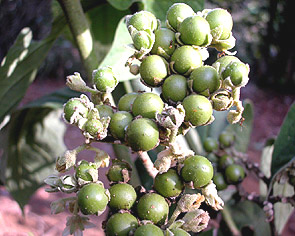|
Solanum L.
Descriptions -- Digested by bats -- Dispersed by bats -- Notes -- Species treatments -- References Description.
Trees, shrubs, or herbs, often of secondary habitats. Stipules absent. Leaves
simple, alternate. Infructescences mostly axillary, the fruits sometimes secund.
Fruits
berries, globose to oblong, greenish or whitish, many seeded. Pericarp
thin, mostly parenchymatous. Seeds ovate, obovate, or broadly elliptic to circular,
flattened, 2.5 x 2 mm, brown, golden-yellow, or white, glossy, the transverse
section elliptic or biconvex, the surface reticulate or undulate-reticulate. Hilum
a narrow marginal slit; micropyle a small marginal hole; vascular bundle short,
not reaching chalaza. Seed coat of 2-3 cell layers, the exotesta of large cells
with thickened, lignified inner and anticlinal walls, the mesotesta thin-walled,
usually crushed, not visible in mature seed, the endotesta a layer of small cells
with thickened walls. Endosperm copious. Embryo linear, curved, differentiated
into cotyledons and hypocotyl-radicle axis. Digested by bats. The thin, fleshy, greenish or white-yellowish pericarp. Dispersed by bats. Seeds. Notes. Seeds of different species of Solanum can be distinguished by using the following characters: shape, color, surface, hilum shape, number of seed coal layers, exotesta and endotesta structure, and endotestal cell walls thickening. Species treatments. S. torvum. Peckham, H. 2000. Dietary habits of two pairs of sympatric frugivorous bats in the dry season in French Guiana. Poster, 30th Annual North American Symposium on Bat Research, University of Miami, Coral Gables, Florida. 1 pp. Masson, D., M. Breuil & A. Breuil. 1990. Premier inventaire
des chauves-souris de l'ile de Marie-Galante (Antilles françaises). Mammalia
54: 656-658. |
||
